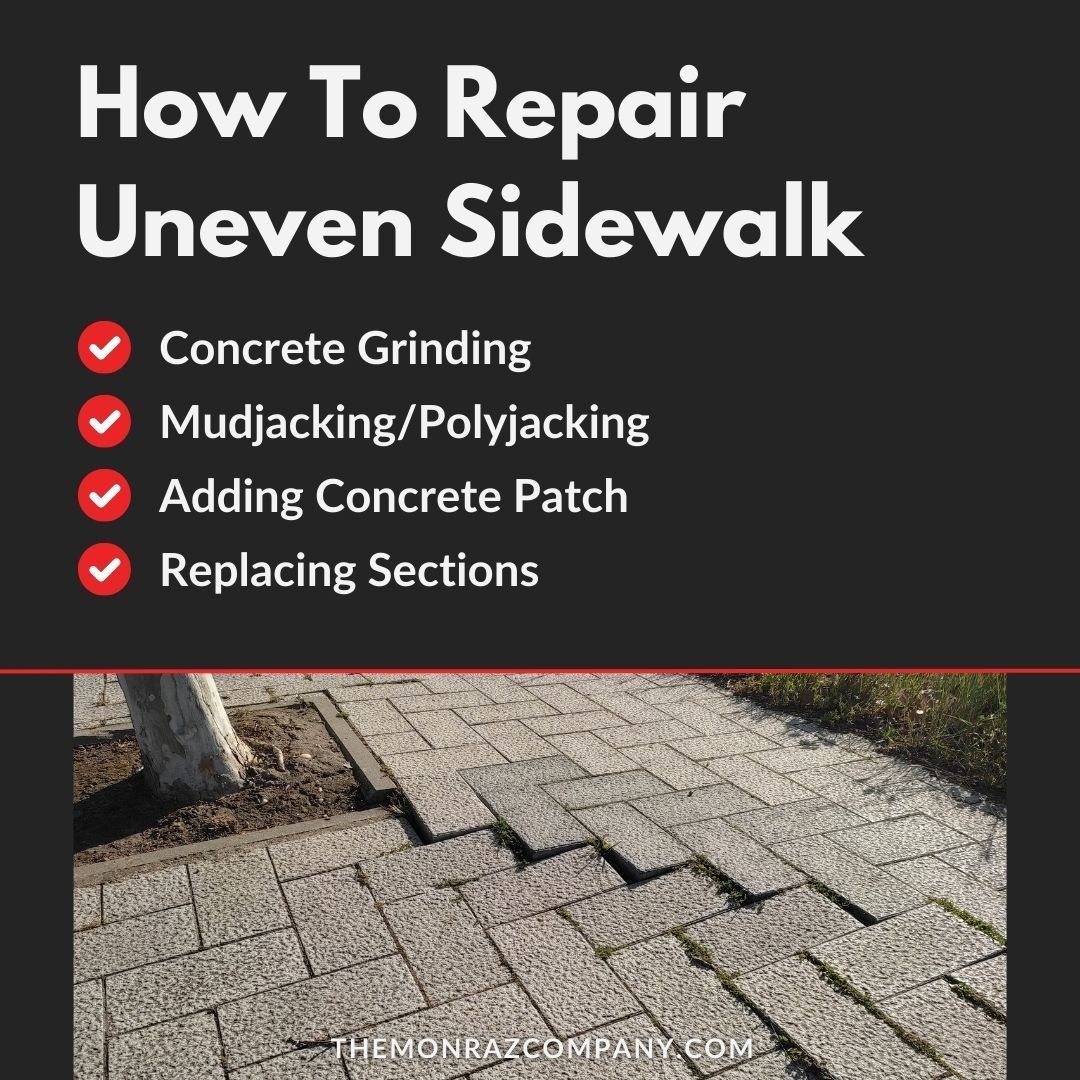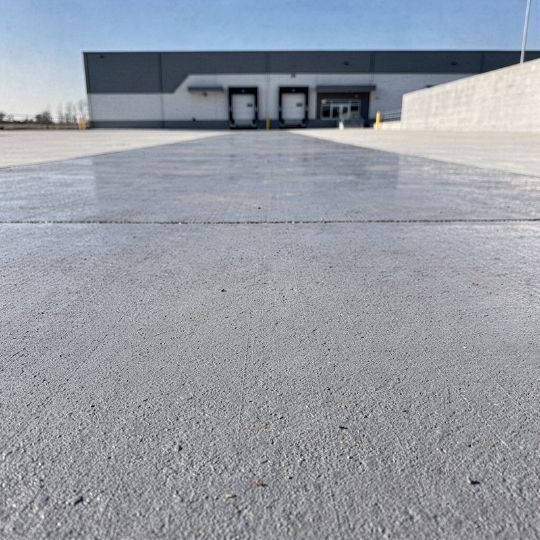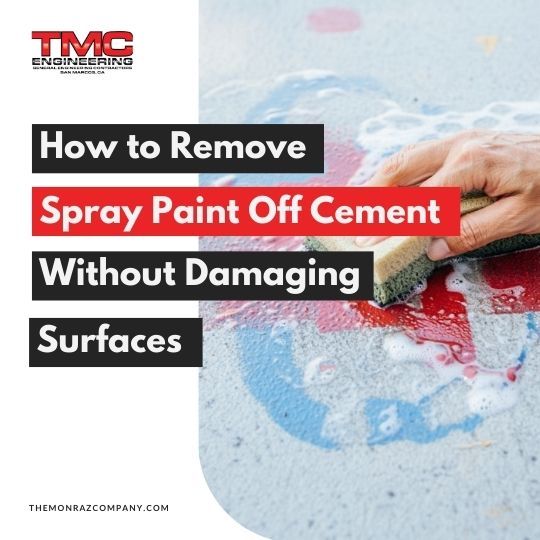How To Fix Uneven Sidewalk
Sidewalks are generally made of poured concrete due to its strength and resistance to wear and tear. It can withstand both foot traffic and all types of weather conditions for a safe and reliable walkway. However, even the strongest material isn’t immune to decay, so overtime time weathering, settling of the earth, and invasive tree roots can all break down a concrete sidewalk.
Cracks or unevenness can be the common concrete sidewalk problems a property owner may encounter. Whether gaps have developed between panels or areas have visibly sunk below grade, an uneven walking area presents trip hazards and liability concerns. On the bright side, there are a number of tested techniques to repair such defects when they appear. From simple grinding to full-scale professional leveling services, property managers have options that can help restore safe pedestrian access and align with city ordinances. We’ll examine all those repair options and more in this post.
But, before you dive in, are you in Southern California and need your uneven sidewalk repairs done effectively and efficiently? Then, call the experts at TMC Engineering ! We’d love to help you with your gravel projects or any other concrete or asphalt work!

How To Fix Uneven Sidewalk
Sidewalks are mostly of poured concrete, which is durable and resists wear from heavy foot traffic and different kinds of weathering . However, the effects of weather, ground settling, or even root intrusion may someday weaken its integrity. When this happens, cracks or unevenness form.
More than just a detractor from curb appeal, uneven sidewalks pose some legitimate safety and compliance concerns and should be dealt with. These problems can easily trip unsuspecting pedestrian if the offsets are more than about one-half inch in height. Especially hazardous are vertical differentials that jeopardize stability. Older adults, and those with second-tier physical limitations, are at heightened risk of falls from an unexpected change in grade. Property owners are rightly liable should such a scenario arise due to a known, ignored defect under their control. This is why cities require sidewalks be maintained by property owners.

Who Is Responsible For Uneven Sidewalk?
The property owner adjacent to the sidewalk is the one responsible for regular maintenance. This is enforced by local municipalities and not only can property owners be liable if someone is injured on their walkway, but the city may fine you for every day a known problem is not fixed. Maintenance of your sidewalk is essential. Required maintenance can include everything from seasonal snow scooping and leaf removal as well as repair of cracked or heaved surfaces.
How To Repair Uneven Sidewalk
There are several methods for repairing uneven sidewalks depending on the severity of the issues. Consulting with a professional is recommended for complex jobs to ensure repairs are done properly. However, some basic techniques can be attempted by property owners for minor leveling needs if done with care.
Concrete Grinding
In cases where there are slight differences in height less than 1.5 inches, concrete grinding is an excellent option that is relatively inexpensive. It utilizes a floor grinder equipped with diamond-coated cups or discs, which very slowly shave down high spots on the sidewalk surface. Because this process removes thin layers, the grinder can often level uneven areas. Even though it may not exactly correspond with the concrete surrounding it, grinding can essentially eliminate the trip hazard without having to replace whole panels.
The actual grinding process is fairly straightforward, but it should be conducted only when properly equipped with protective mask, eyewear, and ear coverings. Dust from concrete contains extremely fine particles that can be hazardous if ingested.
Always start by brush ing away any loose debris to prevent clogging the grinding blades or spreading dust. Use long sweeping strokes with the grinder head, gradually flattening raised sections until the surface lies within code-compliant height differentials. Inspect finished work with varying light angles to reveal any remaining variations that may exist outside of specification. When finished, dispose of leftover concrete waste. Local ordinance prohibits you from dumping debris into the storm drain.
Since it’s low cost and the process is pretty simple, grinding is the preferred method of repair for small sidewalk leveling projects.
Steps:
- Sweep away any debris.
- Grind down high spots with a grinder.
- Dispose of the debris properly.
- Check for remaining tripping hazards.
Mudjacking/Polyjacking
Mudjacking and polyjacking are other methods of rais ing and level ing a sunken sidewalk slab without dealing with the demolition and reconstruction process. They work using hydraulic force applied from below with manually injected grouts that are specially formulated to cure in a supportive matrix. Depending on the amount of settlement, it may take one or multiple lifts of the application of grout to raise the slab to the desired grade.
Grout, in the case of mudjacking, is a fluid mix of soil, cement, and water pumped into holes drilled along the perimeter of sunken areas. For polyjacking, it harnesses the expanding polyurethane chemical reaction to raise stubbornly settled sections. Both, in the long term, harness the pressure building beneath the slab to incrementally lift concrete slabs.
Equipment needed includes an electric drill with mixing attachment for combining mudjacking grout, grout pumping machines with injection hoses, and forming materials. It can take several days and multiple applications depending on the severity of the drop. Doing too much at once could crack the concrete or weaken it.
Steps:
- Drill injection holes where needed.
- Pump grout mixtures beneath to raise sections.
- Grind or fill any visible holes once cured.
- Inspect for proper leveling.

Adding Concrete Patch
For small depressions that are less than 1/2 inch deep, self-leveling concrete patching compounds can make quick work. These compounds come pre-mixed with a combination of cement, sand, and special additives. When poured into a drop, they dry and cure into level, smooth slabs, seamless with the surrounding concrete.
Though this process is simple, proper preparation is essential for a lasting bond. You can make adhesion more successfully by scrubbing the low area and roughening of the perimeter edge. Use wire brushes or a grinder, grind the surface until the texture is coarse. T hen apply an even layer of compound using a marginal trowel, working it deeply into the void. You can find patching products that set quickly to repair your area in a timely fashion.
Once finished, allow it to fully cure before exposure to traffic or moisture. Curing time is typically 24 hours , but check the label for specific instructions . After it has dried, use a float trowel to smooth out any roughness and feather the perimeter using slight, deliberate movements.To make the repair even more effective, use a penetrating waterproofer or sealer. Though patching is quick and easy, you may still have issues if there are underlying problems like tree roots or unstable soil.
Steps:
- Completely clean the patch area.
- Mix and apply the patching compound.
- Smooth and feather the edges when it is dry.
- Apply sealing emulsion if needed once it is cured.
Replacing Sections
In some unfortunate cases where settling, root intrusions, or excessive cracking have compromised more than 50% of a sidewalk panel’s integrity, complete removal and replacement is necessary. Slabs that have dropped several inches below surrounding grade pose safety risks not easily addressed by other patching or leveling strategies.
Proper planning ensures that the replacement work is done according to the code. Contact the local municipality to determine how best to dispose of old material, acquir e appropriate permits, and achieve appropriate constructions standards. Mark utility lines and inspect for potential conflicts before demolishing the existing structure.
Use a concrete saw and cut perimeter outlines square to make it easier to remove in intact sections. Excavate to a depth of about 4 – 6 inches to accommodate the placement of new compressible backfill, then form and pour. You’ll also need rebar to reinforce the concrete’s structural integrity.
Smooth and finish the fresh concrete per specifications, then apply required curing procedures such as misting or covering with a permeable sheet for optimum strength development. Accurate subbase repair helps prevent future settling in the new slab. While a higher initial cost, replacement provides the best walking surface, without defects, if done properly. For involved projects that impact infrastructure at a site, use only qualified professionals experienced in transportation construction best practices.
Fixing uneven sidewalks with the right method keeps your walkway safe and compliant.
Although fixing uneven sidewalks requires some labor and skills, basic techniques allow for cost effective repairs that both preserve your property’s appearance and functionality while enhancing safety for all visitors and pedestrians. With the right materials, tools, and techniques, you can restore safe, uniform walking surfaces that’ll still be going strong years later. For complex needs, professional assistance delivers long-lasting, compliant results efficiently.
For additional tips on concrete repairs, refer to our posts on our blog such as how to patch holes in concrete and why does concrete crack . These posts and others like it on the page provide valuable information on the root causes of issues in concrete surfaces and how to correct them.
Here at TMC Engineering , we have a deep commitment to delivering projects characterized by the highest safety standards as well as workmanship and client satisfaction. We aim to provide you with valuable informative content and insights related to the services our team of experts provides!
Whether you require asphalt paving , striping, sealing , or concrete work , we offer a full suite of transportation construction solutions. Because our team member’s experiences range from 20 to 33 years in this industry, we can work in all weather conditions and have challenged them for our own confirmation. We invite you to contact us today for a FREE QUOTE . Let’s make quality projects together!




